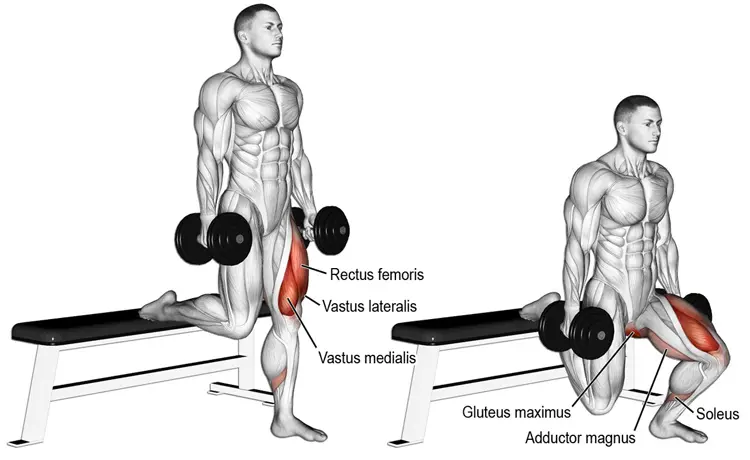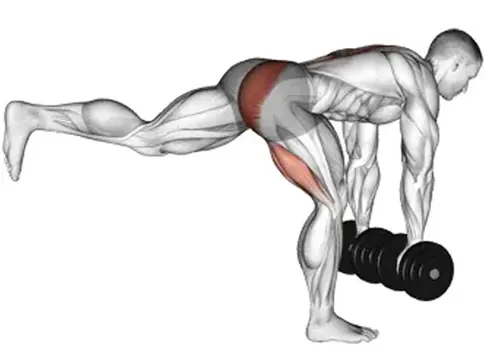We’re big fans of squats and deadlifts at Fitness Volt. These two exercises are amongst the most productive and satisfying things you can do at the gym! But, as much as we love these two compound exercises, we love lunges almost as much.
Why?
Unlike squats and deadlifts, lunges work one leg at a time, and that’s very beneficial. Unilateral exercises like lunges are useful for developing balance and coordination and fixing left-to-right strength imbalances. Lunges are also good for your lower body mobility and flexibility.
Unfortunately, lunges can also be hard on your knees. If you’ve got healthy joints, you may not notice, but if you’ve already got bad knees and suffer from knee pain, lunges may be more painful than they are beneficial.
Lunges put stress on your knee joints in several ways:
Excessive forward knee travel – lunges can cause your front knee to travel forward and beyond your toes. This increases joint stress. Of course, you should do your best to keep your front shin vertical when doing lunges, but that’s easier said than done. If you’ve got very bad knees, even a little forward travel can cause increased knee pain.
Level Up Your Fitness: Join our 💪 strong community in Fitness Volt Newsletter. Get daily inspiration, expert-backed workouts, nutrition tips, the latest in strength sports, and the support you need to reach your goals. Subscribe for free!
Lateral instability – lunges require and develop balance. However, you may find that wobbling from side to side causes knee pain. This is especially true if you’ve got damaged your collateral or cruciate ligaments.
Shearing force – lunges involve stepping forward, stopping, and then descending. The action of stopping increases shearing force in your knee joint. In simple terms, your tibia (shin bone) stops moving, but your femur (thigh bone) tries to continue traveling forward. This braking puts stress on the knee joint, the articular cartilage, and the muscles and ligaments of the knee. Walking lunges are tough on the knee joints, as are very dynamic/fast forward lunges.
The 10 Best Alternatives to Lunges for Bad Knees
Do lunges hurt your knees? The good news is that there are plenty of things you can do instead. Some are unilateral exercises, while others just work the same muscles as lunges but in a more knee-friendly way. Try them all to find the exercises that cause the least amount of knee pain.
1. Split squats
Split squats are a type of static lunge. Instead of stepping forward and then pushing back into the starting position, you stay in a split stance. This reduces the shearing force on your knees and makes it easier to keep your front shin vertical.
You can do this exercise with just your body weight for resistance or you can use a barbell or dumbbells. Smith machine split squats are also a good option, especially if you need help with balancing.
Learn how to do split squats in our in-depth guide.
2. Bulgarian split squats
While it’s not really clear what this exercise has to do with Bulgaria, it’s still a great way to train your lower body, one leg at a time. With Bulgarian split squats, you elevate your back foot, which gives you a larger range of motion. If you’ve mastered regular split squats (#1), then this is a useful progression.
Like split squats, there is very little shearing force on your front knee, and you should be able to keep your front shin more-or-less vertical. However, you’ll need decent balance and stability to avoid too much lateral movement.
Check out our detailed guide to all the Bulgarian split squat.
3. Step-ups
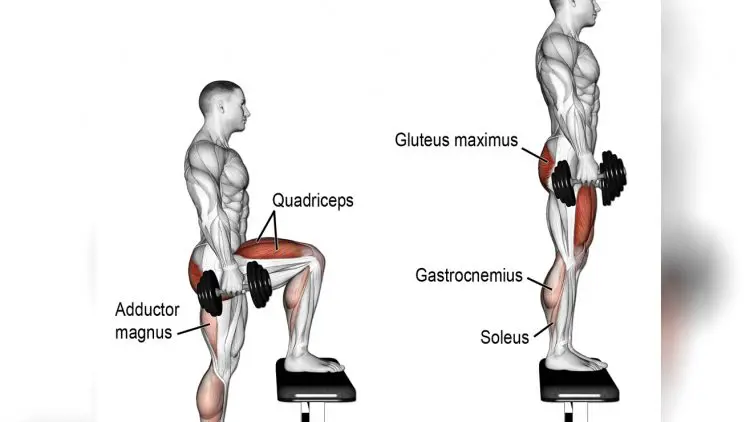
Lunges and step-ups are very similar, but step-ups are usually more knee-friendly. Stepping up instead of forward puts a lot less shearing force through your front knee. It’s also easier to maintain that all-important vertical shin.
The key to getting the most from step-ups is to use your trailing leg as little as possible. Don’t push off the floor. Instead, keep your trailing knee mostly straight, and try pulling your foot up so you can’t drive off your toes. This ensures that your front leg does more of the work. You can do step-ups with dumbbells or a barbell, or just using your bodyweight.
Make step-ups harder by using a higher step but, be warned, the higher the platform, the more stress there will be on your knee joint.
Find out more about this awesome step-ups exercise here!
4. Single-leg leg press
The leg press is mostly thought of as a bilateral or two-legged exercise. However, there is nothing to stop you from doing this exercise one leg at a time.
Single-leg leg presses make this exercise a viable alternative to lunges. Like lunges, you can use this exercise to correct left-to-right strength imbalances. However, because the weights are guided on rails, you won’t have to worry about balance and should have no problem keeping your knees correctly aligned.
Learn more about leg presses in our detailed guide.
5. Wall squats
Level Up Your Fitness: Join our 💪 strong community in Fitness Volt Newsletter. Get daily inspiration, expert-backed workouts, nutrition tips, the latest in strength sports, and the support you need to reach your goals. Subscribe for free!
While wall squats are an isometric bilateral or two-legged exercise, they are especially knee-friendly, which is why they’ve made it onto our list. With wall squats, you descend and then hold your squat, which puts pressure on your muscles while sparing your joints. This is an especially good exercise if your knee pain is caused by arthritis.
Because wall squats are an isometric exercise, you do them for time and not reps. For example, you might hold the squat for 30 seconds. The harder you push your back against the wall, the harder this exercise becomes.
Find out how to do wall squats here!
6. Goblet squats
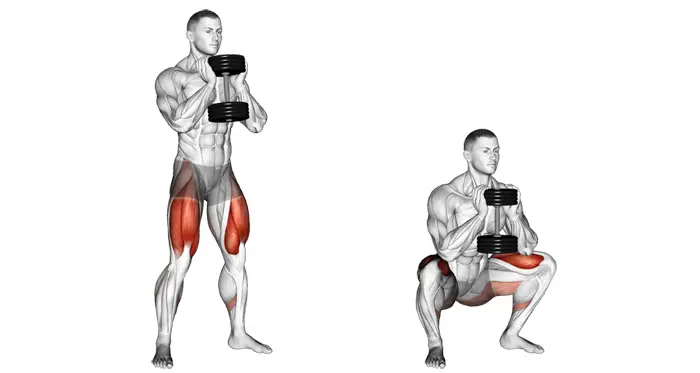
Goblet squats work the same muscles as lunges, but you may find them easier on your knees. They can be done with a kettlebell or a single dumbbell as preferred.
Done correctly, you should have no problem keeping your shins mostly vertical to take the stress off your knees. Also, avoid descending too far below parallel in case that aggravates existing knee problems.
Find out more about goblet squats here.
7. Box squats
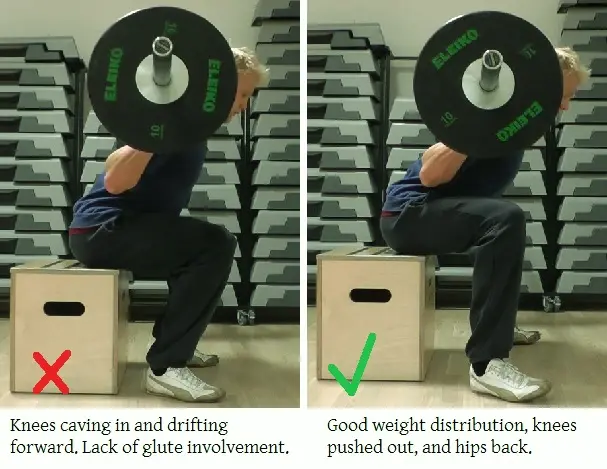
Box squats make regular barbell front or back squats more knee-friendly. Squatting to a box can reduce knee pain by:
- Stopping you from descending too fast
- Preventing you from squatting too deep
- Making sure you keep your shins vertical
Powerlifters do this exercise to increase explosive power out of the bottom of their squats, but you can use it to work your legs without hammering your knees.
Learn more about box squats and how they differ from regular squats in our in-depth guide.
8. Sled drags
Dragging a sled might seem like an unlikely alternative for lunges, but it’s actually one of the best! Pulling a sled puts very little pressure on your knee joints but still provides your legs with an intense workout.
Walking forward while dragging a sled emphasizes your glutes and hamstrings while walking backward targets your quadriceps. You can also walk sideways to work your hip abductors and adductors.
However, you do them, sled drags are a very joint-friendly way to work your legs.
Read more about sled training in this detailed article.
9. Single-leg Romanian deadlifts
Sometimes, the best way to avoid knee pain is to avoid moving your knee joints too much. Wall squats (#5) are one way to do this, and single-leg Romanian deadlifts are another. This exercise is good for your balance and also works your glutes and hamstrings. However, unlike lunges, it does not affect your quads to the same degree, and that’s what makes it easier on your knees.
If your knees are particularly sore, but you still want to train, this exercise may be a viable option.
How to do it:
- Stand with your feet together. Shift your weight over onto one leg.
- Without rounding your lower back, hinge from your hips and lean forward. Reach down and touch the floor with your hands. Extend your non-weight-bearing leg out behind you for balance.
- Stand back up and repeat.
- Make this exercise harder by holding dumbbells.
- If you find it hard to balance, do this exercise next to a wall and use your nearside hand for support. Move away from the wall as your balance improves.
10. Single leg drop down squats
This exercise is a sort of reverse step-up. Instead of starting on the floor and stepping up onto a platform, you start on the step and lower yourself down instead. This move works the same muscles as lunges, but the range of motion and the movement itself should be more knee-friendly.
How to do it:
- Stand on one leg on a stable step or bench. Extend your arms in front of you for balance.
- Bend your supporting leg. Keep your other leg straight and extend it slightly in front of you.
- Descend as far as you comfortable can or until the heel of your other leg lightly touches the floor. Do not let your supporting knee travel forward past your toes.
- Stand back up and repeat. Try to do the same number of reps on each leg.
- This exercise is a good precursor to pistol squats.
Wrapping Up
While lunges ARE a fantastic exercise, they aren’t for everyone. Some people just don’t like them, while others find that they aggravate existing knee pain. Needless to say, if your knees hurt, you should seek medical advice to determine the source of your pain and avoid exercises that make it worse.
Assuming it’s safe to do so, there are lots of knee-friendly exercises you can do instead of lunges. Each of the ten exercises listed above is every bit as effective but should cause less knee joint stress.
That said, almost every lower body exercise involves the knees, so you may still find that some of these exercises cause discomfort. Try them all to determine the best options for you. If an exercise makes your knees worse, skip it and move on to the next. At least a few of them should be an effective alternative to lunges for bad knees.
Interested in measuring your progress? Check out our strength standards for Bulgarian Split Squat, Box Squat, Goblet Squat, and more.

